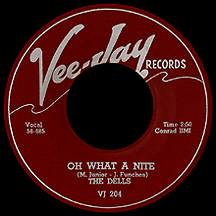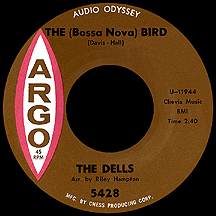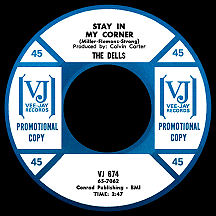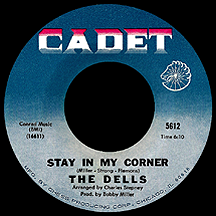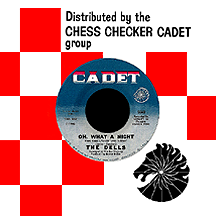THE DELLS
It's fairly common for a music act to rerecord their own hit song, but seldom does such a repeat attempt result in a hit all over again. It's even less likely for the song to become more popular the second time, yet The Dells pulled off this feat...twice! The original version of the ballad "Stay in My Corner" on Vee-Jay Records made the R&B charts in 1965, hitting much bigger three years later when a new version on the Cadet label (running over six minutes!) reached number one on the R&B charts and became the quintet's first top ten pop hit. Then an attempt to revive their 1956 hit "Oh What a Nite" paid off when a slick, soulful 1969 version repeated the success of "Corner" and put the group in the record books under the heading "Lightning Strikes Twice and then Doubles Itself" (or would, at least, if such a heading existed!)
The vocal group first came together around 1952 at Thornton Township High School in Harvey, Illinois, a Chicago suburb. Six members made up the ranks: baritones Marvin Junior and Mickey McGill, tenors Verne Allison and Lucius McGill, bass Chuck Barksdale and lead singer Johnny Funches. Calling themselves El Rays, their tight harmonies were exceptional for such a young, inexperienced group (all 15 to 17 years of age). Lucius left early on and the remaining five cut a single for the Windy City's premier rhythm label, Chess. "Darling I Know" came out in '54 on sister label Checker. It turned out to be one of the company's failed early attempts at recording a doo wop-type group (having previously focused mainly on blues, the Chess and Checker labels had success with The Moonglows and The Flamingos in '55 and '56).
Vee-Jay Records, headquartered less than an hour's drive away in Gary, Indiana, popped up in 1953 to compete for Lower Lake Michigan dominance in the rhythm and blues market; though never achieving quite the level of the Chess brothers' operation, the label had major success over the next decade-plus. The Spaniels and The El Doradoes were Vee-Jay's early vocal group stars, and the El Rays headed right over there as soon as Chess made it clear they weren't interested in doing any more sessions with them. With Chess group The Rays and Vee-Jay's El Doradoes providing competition, they changed their name to The Dells. Label owners Vivian Carter and James C. Bracken gave such groups more of a chance to develop; when the first single "Tell the World" (a notable improvement over the El Rays disc) didn't catch on, they found themselves back in the studio instead of on the street. The third VJ release was the winner. "Oh What a Nite," a successful hybrid of rhythm and rock with an effortless lead vocal by Funches, was a top ten R&B hit in late 1956.
The five had difficulty following the hit with another. Patience would be the key. Ten more singles were released by Vee-Jay over the next few years with airplay and sales at near nonexistent levels, yet the group was a solid concert draw thanks to "Oh What a Nite" and their considerable vocal talents and stage presence. An auto accident en route to a scheduled gig in 1958 resulted in injuries to most of the group members, most seriously McGill, whose leg was torn up so badly that he need a couple of years to recover. The experience was quite a blow to the five and they decided to break up, at least for awhile, and consider what the future might hold for each of them. Chuck Barksdale was the only one to work in the business between '58 and '60, joining a reconfigured Moonglows lineup, establishing ties with that group's members (including leader Harvey Fuqua and Marvin Gaye) that would come in handy later.
The Dells reformed in 1960 minus a disillusioned Johnny Funches, who decided to pursue another line of work (in a steel mill of all things, where he was employed for many years). Former Flamingos tenor and falsetto singer Johnny Carter replaced him, and with Junior, Allison, McGill (healed from the accident and raring to go) and the returning Barksdale, the roster was set; it would stay as such for the better part of five decades. Without a record label, they broadened their musical interests, studying jazz vocal techniques, and served a two-year stretch backing Dinah Washington on tour. Joining Chess again in 1962, their efforts were released this time around on the company's Argo subsidiary. Jumping on the "bird" dance bandwagon (one of Carter's nicknames was "Bird Man"), they appeared on the charts for the first time since '56 with "The (Bossa Nova) Bird," a borderline novelty tune that had them playing against type.
Working constantly in the early '60s despite the lack of hit records, they appeared prominently on one major hit, providing the 'shoo-bop-shoo-bop, my baby' background hook for Barbara Lewis's "Hello Stranger" in 1963. Through his association with Fuqua, Gaye and other Motown regulars, Barksdale sidelined as a songwriter, scoring a minor hit with "Use Your Head" (cowritten with Barrett Strong and Wade Flemons), the second single by Mary Wells on 20th Century-Fox after her controversial departure from Motown Records. The Dells returned to the Vee-Jay label in 1964 for a few 45 releases; it was in June '65 that the first version of "Stay in My Corner" became a top 30 R&B hit. When Vee-Jay filed for bankruptcy in 1966, they were again without a label and briefly joined Ray Charles on tour as a backing group. By the end of the year they returned to Chess for a third go-around, this time being placed on the Cadet subsidiary (actually a new name for their former Argo label)...and that was when everything started falling into place.
Leonard Chess issued a challenge (or more accurately a threat) to his staff of producers: deliver hit records or their jobs would be in jeopardy. Songwriter-producer Bobby Miller and arranger Charles Stepney had an idea to use the five older, but individually unique, Dells singers in updated and sometimes experimental ways, utilizing the diversity in their voices, not so much alternating leads as some acts did (The Temptations are one example) but blending them together in clever ways, Junior's raspy baritone interspersed with Carter's falsetto and Barksdale's deep bass. The fourth Cadet single, "O-O I Love You," had the right mix and put them on the charts during the 1966 holiday season. It was the start of a nonstop chart run lasting more than a decade.
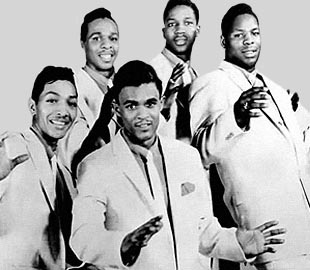
"There Is," written by Miller with Raynard Miner, was rejected by the group at first because it was set to a marching beat, but Stepney played with the arrangement and the result was an infectious blast of energy. Still, it was relegated to the B side of "O-O" until a station in Philadelphia began giving it heavy spins. Cadet released the song again with a different flip side and in February '68 it became the group's first top 20 pop hit and biggest R&B smash since '56. Miller's "Wear it On Our Face," with its opening opus of piano and clanking cans, matched the fervency of "There Is." Stepney did some moonlighting at this time with longtime Chess act The Radiants, cleverly but confusingly arranging their spring single "Hold On" in the same style as the two previous Dells hits. To listeners not yet familiar with the group's distinctive voices, it seemed like the Dells had exploded onto the airwaves in those early months of 1968.
An elaborate concert crowd-pleaser came next with round two of "Stay in My Corner," the new version clocking in at six minutes and ten seconds, highlighted by Marvin Junior holding a 16-second note on the 'baaay...' part of 'baby.' Hesitant to release the entire track as a single (certain airplay poison), Cadet gave in at the insistence of everyone creatively involved (though stations were sent promos with an edit on one side). It became the all time biggest Dells hit that summer, number one R&B and top ten pop, yet it wasn't the lengthiest 45 to hit the market in the '60s (at 7:20, "Mac Arthur Park" by Richard Harris was in the top 40 at the same time, The Beatles' "Hey Jude" came close at 7:11 a few months later, then in the spring of '69, instrumental "The Minotaur" by Dick Hyman and his Electric Eclectics outstretched them all at 7:30).
"Always Together," the fourth straight Dells hit of 1968, became a signature song some years later as the group's longevity became more obvious, passing the 20, 30, and even 40-year mark without a change in the five-man lineup. Then Peggy Lee's Oscar-nominated perfomance in the 1955 film Pete Kelly's Blues gave the Dells an idea for a big summer '69 hit. "I Can Sing a Rainbow" (sung by Lee in her "nut house" scene as Barksdale accurately called it) was done as a medley with "Love is Blue" (Paul Mauriat's instrumental chart topper from a year before with lyrics) and the group's hot streak continued.
It was Leonard Chess, perhaps feeling nostalgic one day, who suggested they try updating another of their older songs, this time the one that had first put them on the map, "Oh What a Nite." As he had done on several other songs, Chuck Barksdale led off the new version with a spoken intro ('...well, to the old and to the new, we rededicate this song to you') and the soul-injected reprise of the slightly-renamed "Oh, What a Night" lit up the late summer and fall of 1969, sending them back to number one on the R&B charts and into the pop top ten. Johnny Funches, still working at that steel mill as far as anyone knew, retained one connection to the more contemporary Dells, collecting royalties as the song's cowriter (with Marvin Junior).
Whether creating anew or revising the past, the Dells were right on pitch; Miller and Stepney had many inventive ways of blending and contrasting their distinct voices, and they continued scoring R&B hits and the occasional pop hit, including "The Love We Had (Stays on My Mind)" in 1971. Detroit producer Don Davis (who had a good track record with Johnnie Taylor, The Dramatics and others) took over in 1972 with positive results; "Give Your Baby a Standing Ovation," written by Henry Williams and Motown trailblazer Marv Johnson, hit strong the following year. Switching to Mercury in 1975 and later to the ABC, 20th Century and Private I labels, the group continued at a less spectacular level but maintained their following and a considerable run of minor chart singles kept them in business through the mid-1980s.
When the hits stopped, they didn't. Funches passed away in 1998, dashing any long-lost hopes of an onstage reunion and "Oh What a Nite" encore. But that fresh start in 1960 with Junior, Allison, McGill, Barksdale and Carter had become a permanent one; they stayed together though thick and thin in contrast to most any music group you can name (the tightly-knit Four Tops excluded). At the time of Johnny Carter's death in 2009, The Dells had logged 49 years with the same lineup.
NOTABLE SINGLES:
- Darling I Know - 1954
as El Rays - Tell the World - 1955
- Zing Zing Zing - 1955
- Oh What a Nite - 1956
- Movin' On - 1957
- Q-Bop She-Bop - 1957
- The (Bossa Nova) Bird - 1962
- Shy Girl - 1964
- Stay in My Corner - 1965
- Run For Cover - 1967
- O-O, I Love You - 1967
- There Is - 1968
- Wear it on Our Face - 1968
- Stay in My Corner - 1968
- Always Together - 1968
- Does Anybody Know I'm Here - 1969
- Hallways of My Mind /
I Can't Do Enough - 1969 - I Can Sing a Rainbow/Love is Blue - 1969
- Oh, What a Night - 1969
- On the Dock of the Bay - 1969
- Oh What a Day - 1970
- Open Up My Heart /
Nadine - 1970 - The Love We Had (Stays on My Mind) - 1971
- Give Your Baby a Standing Ovation - 1973
- My Pretending Days Are Over - 1973
- I Miss You - 1974


